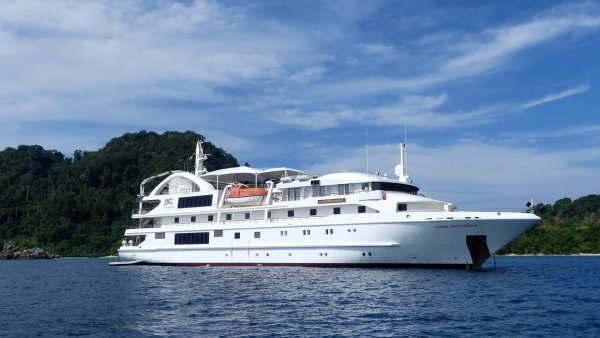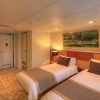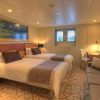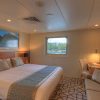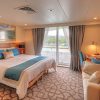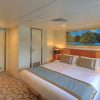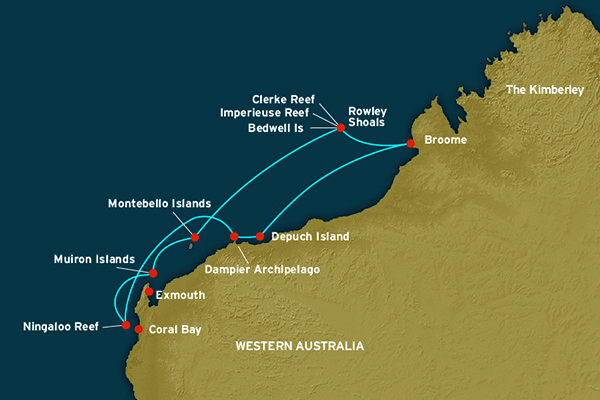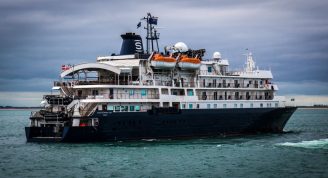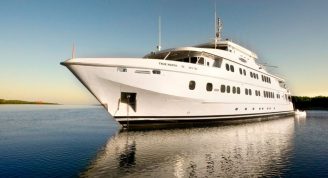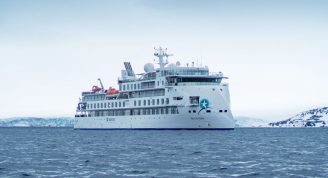Description
Join our pioneering voyage down Western Australia’s Coral coast on board Coral Discoverer. This “scouting” voyage will be the first time we explore this extraordinary marine environment. Departing Broome, we will visit the spectacular Rowley Shoals Marine Park, the Dampier Archipelago and the historic Montebello Islands. Our voyage will culminate with a visit to Ningaloo Reef, home to the gentle and giant whale sharks and manta rays. Our marine experts and guides will lead our discovery of the untouched atolls, mega marine fauna and rare bird species that are found in this pristine coastal habitat.
This voyage is in partnership with Australian Geographic.
Trip Name
Ningaloo & The Bluewater Wonders of Australia's West 2020
Days
13
Overview
Vessel Type: Luxury Expedition
Length: 63 metres
Passenger Capacity: 72 (in 36 rooms)
Built: 2005 / Refurbished: 2016
Launched in 2005, Coral Discoverer set a new benchmark standard for small ship cruising in Australia. Refurbished in November 2016, she continues to raise the bar to new levels of sophistication in expedition cruising in the Southern Hemisphere.
The 1800-tonne Coral Discoverer is the grand vision of Coral Expeditions, pioneers in expedition and adventure cruises around Australia, Papua New Guinea and South East Asia. Her shallow draught and manoeuvrability allow her to go where larger vessels cannot. Her tender vessel, Xplorer, can seat all 72 passengers for excursions to beaches and rivers. Coral Discoverer is equipped with latest technology active stabilisers to ensure comfortable cruising in open waters and is fitted with modern safety and navigation equipment and wireless internet facilities.
Coral Discoverer was built to the exacting international SOLAS (Safety of Life at Sea) standards and specifications in Cairns, Australia, with one aim in mind; to create the ultimate small ship cruising experience. Australian flagged, and staffed entirely by an Australian and New Zealand crew, your experience aboard Coral Discoverer will be unique.
After the refurbishment, the Sun Deck has evolved to become a new social space and the hub of on board community living. This area has been converted into an undercover deck area complete with round ‘Explorer Bar’ with bar stools and sun deck with lounges and an area for outdoor exercise equipment.
Guest accommodation has also received a substantial upgrade with the addition of six Bridge Deck Balcony Staterooms providing coveted inside/outside living quarters. Each of our other Stateroom grades has also received a full upgrade with updated bathroom fixtures, soft furnishings and artwork making for an even more comfortable stay on board Coral Discoverer.
The Coral Discoverer offers five different grades of staterooms, ranging from Bridge Deck Balcony Staterooms to Main Deck Staterooms. Bridge Deck Balcony Staterooms are on the top deck and have private balconies opening out from french windows. All rooms are furnished with contemporary flair and feature original artwork, a small private en-suite, individually-controlled air-conditioning, an iPod dock, ample storage and Australian toiletries. All staterooms are serviced daily. Each stateroom is spacious, sized between 15sqm (161 square feet) to 20 sqm (215 square feet) and has either a balcony, feature picture windows or porthole windows. Most staterooms can be configured to either junior king or twin bedding.
FACILITIES ON BOARD
> Sun Deck with undercover area, sun lounges and ample seating
> Three fully stocked cocktail bars, including brand new round Explorer Bar on Sun Deck
> Spacious, modern dining room, recently refurbished
> Forward lounge
> Reference library
> Gift shop
> Open bridge
> Workout Area
> Wireless internet available for laptops, mobile devices or via onboard guest computer
> Limited laundry facilities available
> SCUBA diving department (selected itineraries)


